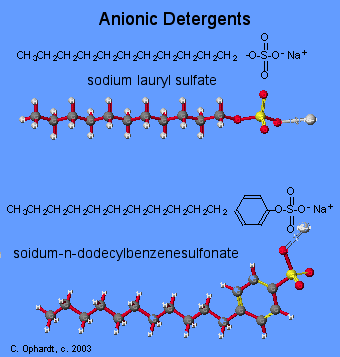DETERGENT
Detergent is used by the barrel at Happy Dale!
Synthetic detergents have similar molecular structures and properties as soap. Although the cleansing action is similar, the detergents do not react as readily with hard water ions of calcium and magnesium. There are over a thousand synthetic detergents available in the United States. Detergent molecular structures consist of a long hydrocarbon chain and a water soluble ionic group. Most detergents have a negative ionic group and are called anionic detergents. The majority are alky sulfates. Others are "surfactants" (from surface active agents) which are generally known as alkyl benzene sulfonates.
Cationic Detergents:
Another class of detergents have a positive ionic charge and are called "cationic" detergents. In addition to being good cleansing agents, they also possess germicidal properties which makes them useful in hospitals. Most of these detergents are derivatives of ammonia.
A cationic detergent is most likely to be found in a shampoo or clothes "rinse". The purpose is to neutralize the static electrical charges from residual anionic (negative ions) detergent molecules. Since the negative charges repel each other, the positive cationic detergent neutralizes this charge.
It may be surprising that it even works because the ammonium (+1) nitrogen is buried under the methyl groups as can be seen in the space filling model.
Neutral or non-ionic detergents:
Nonionic detergents are used in dish washing liquids. Since the detergent does not have any ionic groups, it does not react with hard water ions. In addition, nonionic detergents foam less than ionic detergents. The detergent molecules must have some polar parts to provide the necessary water solubility.
In the graphic on the left, the polar part of the molecule consists of three alcohol groups and an ester group. The non-polar part is the usual long hydrocarbon chain.



Do you trust major detergent manufacturers?
